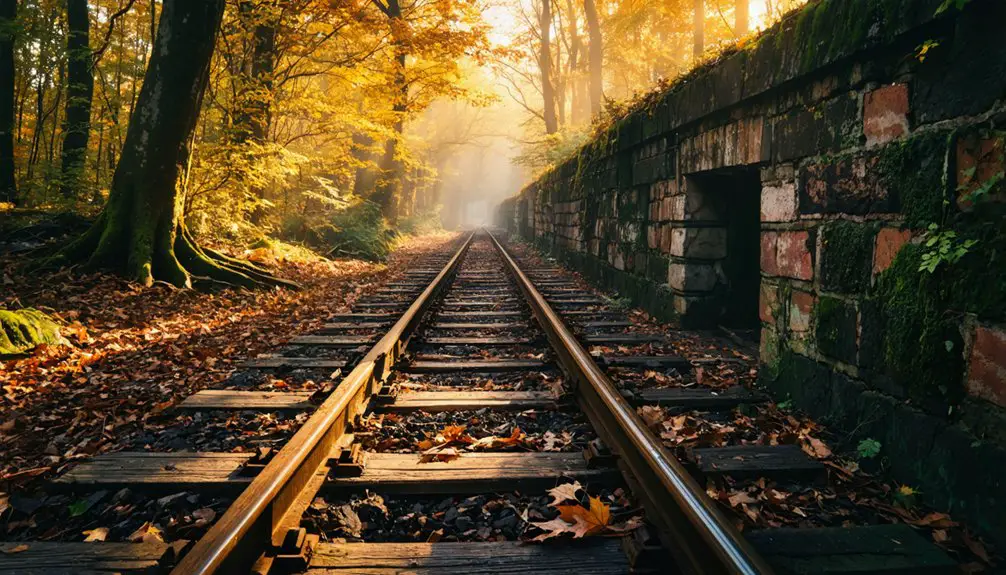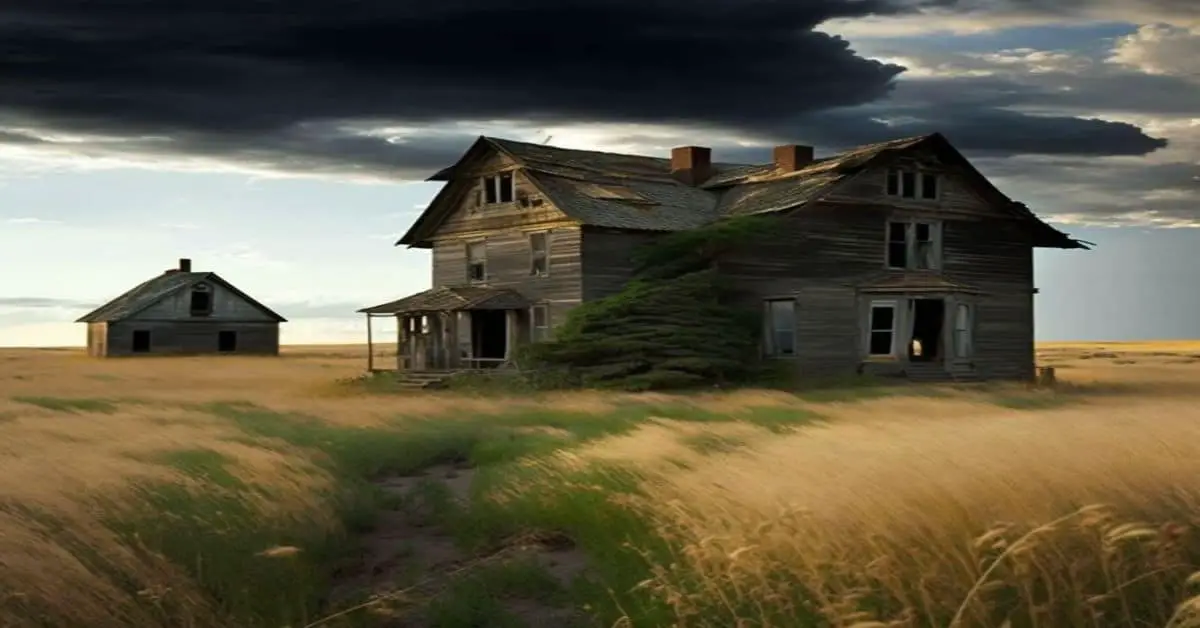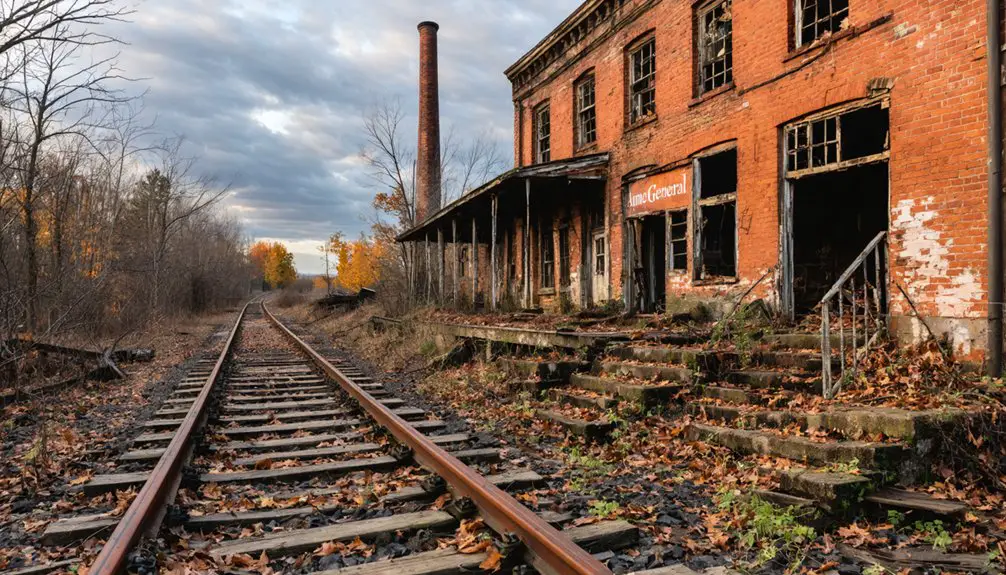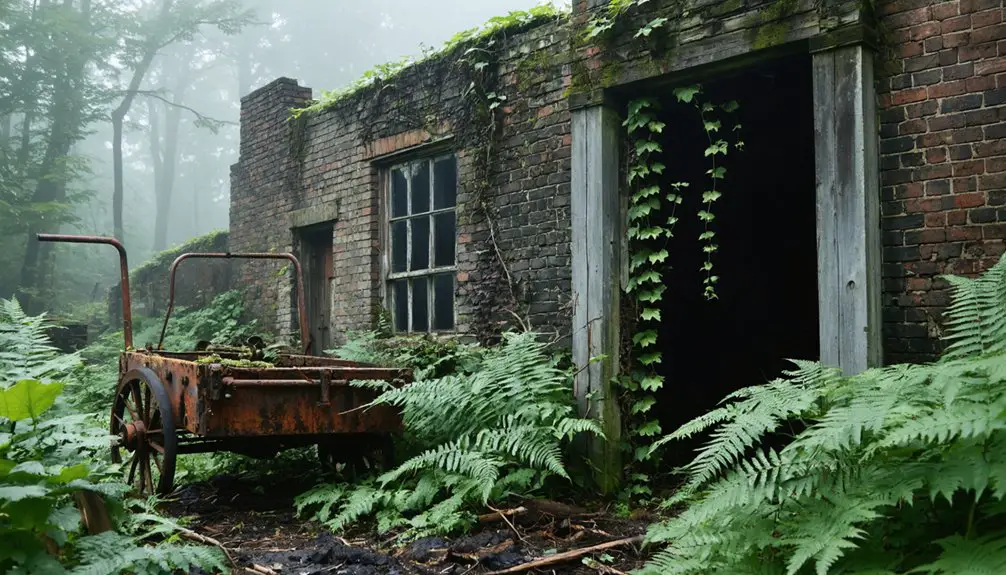You’ll find the remnants of Wehrum hidden beneath thick forest in Indiana County, Pennsylvania. This once-thriving coal mining town, established in 1901 by Lackawanna Coal and Coke Company, housed over 1,000 residents with 250 homes, a hotel, bank, jail, and company store. After devastating mine accidents and the mine’s closure in 1929, families abandoned the town by 1934. Today, concrete foundations and the original jail structure tell stories of Wehrum’s coal-mining past.
Key Takeaways
- Wehrum was a coal mining company town established in 1901 by Lackawanna Coal and Coke Company in Pennsylvania.
- The town housed 1,000 residents and included 250 company houses, stores, churches, and essential infrastructure during its peak.
- A series of mine disasters, including fatal explosions in 1904 and 1909, contributed to the town’s eventual decline.
- The town was abandoned by 1934 after mine closures in 1929, with most structures stripped and removed.
- Today, only the jail structure remains visible, with the Ghost Town Trail allowing visitors to explore former street layouts.
The Birth of a Company Town
When the Lackawanna Coal and Coke Company established Wehrum in 1901, they created more than just another mining settlement – they built a meticulously planned community in Indiana County, Pennsylvania. Named after Henry Wehrum, the general manager of Lackawanna Iron and Steel, this company town emerged to support the No. 4 coal mine in Buffington Township.
You’ll find the town’s mining heritage reflected in its careful layout: six north-south streets intersected by five cross streets, with connecting alleys throughout. A rail line from Vintondale connected the town to broader transportation networks.
The company invested heavily in the community’s infrastructure, constructing about 250 houses alongside essential facilities like a hotel, bank, jail, company store, post office, school, and two churches. Everything you’d need was right there, though your freedom came with strings attached to company oversight. Warren Delano, uncle of FDR, founded the town and oversaw its initial development into a thriving coal mining community.
Life in Early 20th Century Wehrum
If you’d lived in Wehrum during its heyday, you’d have found yourself in one of 250 company-owned houses, living alongside fellow miners who trudged daily to the dangerous work at Lackawanna #4 mine.
Your family would’ve shared the tight-knit community with about 1,000 other residents, gathering at one of two churches or the school for social activities that helped ease the hardships of mining life.
Many of the local miners and their families were immigrants who came from Máramaros region of Hungary to seek better opportunities.
Your wages would’ve been partially tied to the company store’s credit system, while your children played in the streets laid out in a neat grid of six north-south thoroughfares with five cross streets.
The town’s success was short-lived, as the mine closure in 1929 led to its complete abandonment within just five years.
Daily Work and Wages
Though coal mining brought steady employment to Wehrum’s residents, the harsh realities of a miner’s daily wages created constant financial strain.
You’d work 10 to 12 grueling hours underground, facing cave-ins and coal dust, only to have your pay docked for equipment and forced to shop at expensive company stores. Wage disputes erupted frequently as operators manipulated tonnage counts and payment systems. In the 1870s, early labor walkouts began challenging these exploitative practices.
The economic insecurity touched every aspect of life. While miners could earn more than unskilled laborers, your actual take-home pay often fell short of supporting a family.
You’d find yourself trapped in the company store’s credit system, while watching every dollar. Many families turned to gardening and extra work just to make ends meet, building a spirit of community solidarity despite the challenging conditions.
Family Social Activities
Despite Wehrum’s demanding work culture, families found ways to weave rich social connections through the town’s communal spaces.
You’d find family gatherings centered around the town’s two churches, where weddings, festivals, and religious celebrations brought neighbors together. The company store and hotel served as informal meeting spots where you could catch up with friends after a long day’s work.
Your children would attend the local school, which doubled as a social hub for family events and community support.
During times of hardship, especially after the devastating 1909 mine explosion, you’d witness neighbors coming together through church networks to help affected families.
The Russian Orthodox Cemetery stands today as a monument to the strong cultural bonds that united Wehrum’s diverse immigrant community through both celebration and loss.
Housing and Living Conditions
When you lived in Wehrum during its peak years, you’d find yourself in one of 250 company-built houses lined along six north-south streets with connecting cross streets and alleys.
Your wooden home, while modest in design, represented the community’s resilience amid challenging conditions. You’d share your neighborhood with immigrant families, creating a diverse cultural tapestry reflected in local cemeteries and churches. With the mine’s closure in the 1930s, Wehrum’s population quickly declined.
Living near the mines meant dealing with constant coal dust and industrial noise. Established in 1901 as a patch town, Wehrum provided the essential workforce housing for the local coal mining operations.
The housing evolution showed the harsh reality of company town life – you didn’t own your home, and your residence depended on your mining work.
Despite these challenges, you’d have access to essential amenities like the company store, bank, post office, and school, all within walking distance of your front door.
The Rise of Coal Mining Operations
As the Lackawanna Coal and Coke Company established Wehrum in 1901, the town’s mining operations quickly became the lifeblood of this new industrial community.
You’d have seen the impressive Lackawanna #4 mine opening that year, showcasing advanced coal mining techniques focused on extracting high-quality bituminous coal for steel production.
The company’s commitment to the operation was clear when they invested over $1 million in a state-of-the-art coal washer plant.
Despite dangerous conditions and the ever-present risk of explosions, the community’s resilience shone through as miners worked tirelessly to extract coal from the rich seams.
The strategic location along the Pennsylvania Railroad’s Ebensburg & Blacklick Branch meant you could watch trainloads of coal heading to Lackawanna Steel’s plant in Buffalo, connecting Wehrum to the broader industrial network.
The town grew rapidly to include 250 company houses, providing homes for the mining families who formed the backbone of this bustling community.
Disasters That Shaped Wehrum’s Fate
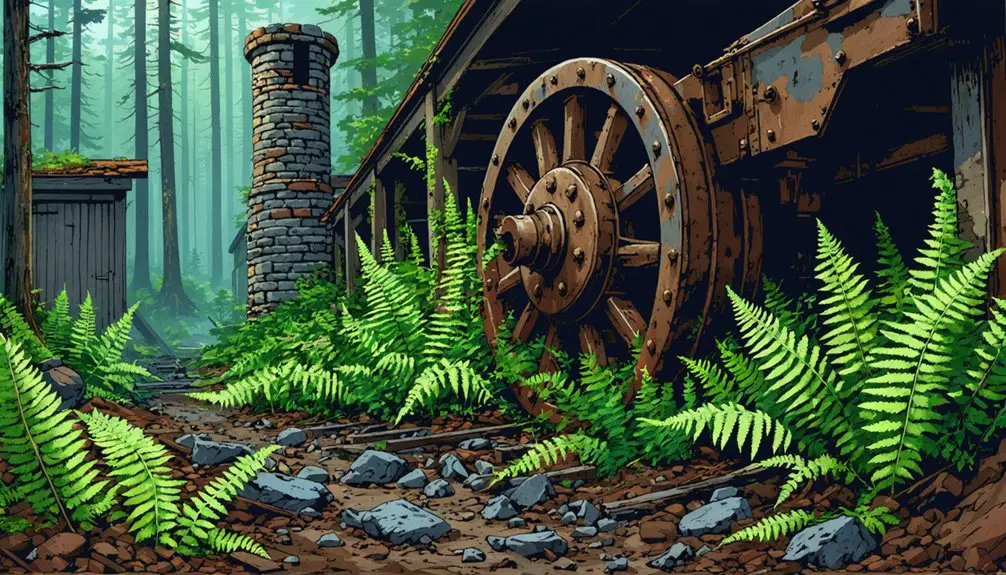
The prosperous early days of Wehrum’s mining operations soon gave way to a series of devastating disasters that would seal the town’s fate.
You’ll find that the disaster impact began with a deadly gas explosion in 1904 that claimed four miners’ lives, followed by an even more catastrophic blast in 1909 that killed 21 and injured 12 workers – a devastating blow to the tight-knit community.
Despite the town’s resilience, industrial fires ravaged the coal washer plants in 1906 and 1914, crippling production capabilities.
When the coal seams started running thin, Lackawanna sold to Bethlehem Steel in 1922. By 1929, they’d shuttered the mines completely.
While the community fought to persevere through each setback, these compounding disasters ultimately led to Wehrum’s abandonment by 1934.
The Human Cost of Mining
Life in Wehrum’s coal mines exacted a devastating human toll that rippled through every aspect of the community. You’d find miners descending 200 feet underground daily, facing deadly hazards like gas explosions and coal dust inhalation with minimal mining safety measures. The original mines featured 500-foot graded shafts for transporting coal efficiently to the surface.
The catastrophic explosions of 1904 and 1909 claimed 25 lives, leaving families shattered and the town’s stability weakened.
Beyond the immediate dangers, workers endured chronic health issues from physical strain and toxic exposures. When accidents struck, the local Miner’s Hospital in Spangler provided limited care, but the toll on community resilience was immense.
Each tragedy left its mark on Wehrum’s social fabric, evident in the cemetery that still stands today – a silent memorial to the sacrifices these miners made to fuel America’s industrial growth.
From Bustling Town to Abandonment
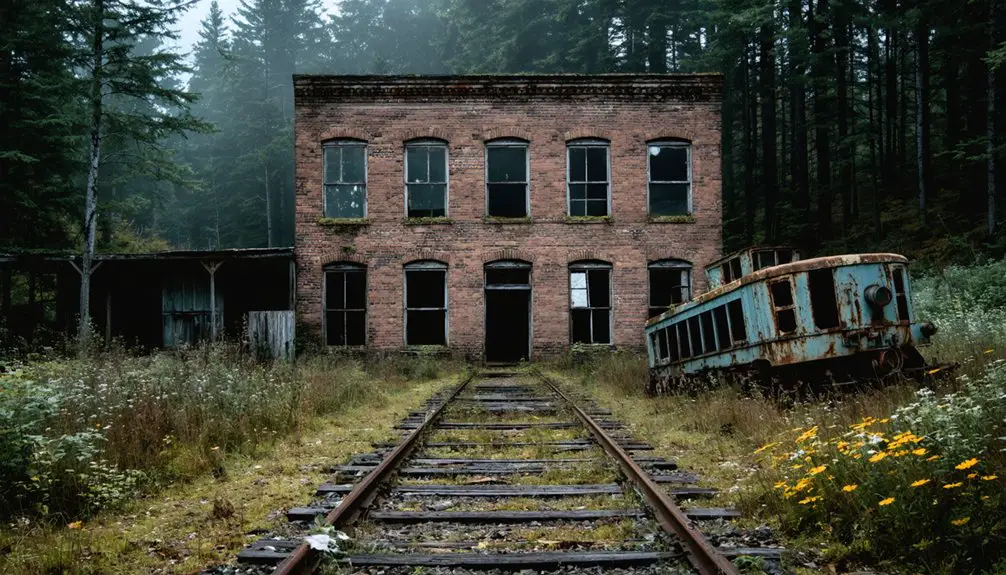
You’d hardly recognize the once-bustling town of Wehrum, which saw its population plummet after Bethlehem Steel’s abrupt closure of the mines in 1929.
Prior mining disasters, including the devastating 1909 explosion that claimed 21 lives, had already tested the community’s resilience.
What remained was quickly stripped and abandoned, as residents scattered to find work elsewhere, leaving behind only foundations and memories of a thriving company town.
Rapid Population Loss Begins
Once bustling with around 250 houses and a thriving coal mining community, Wehrum’s decline began swiftly after the devastating 1909 mining disaster and accelerated when the Lackawanna Coal and Coke Company shuttered its operations in 1929.
You’d have witnessed dramatic demographic shifts as families were forced to leave their homes in search of work elsewhere. The town’s economic dependencies on coal mining meant there weren’t any alternative industries to sustain the population. This mass exodus mirrors modern Pennsylvania’s continued population decline, as projected by the Independent Fiscal Office.
Within just five years of the mine’s closure, the last residents had departed, leaving behind empty streets and crumbling buildings. The company’s systematic dismantling of houses and infrastructure hastened the exodus, as they recycled materials for use in other towns.
Mining Disasters Strike Hard
While Wehrum’s coal mines promised prosperity for its hardworking residents, a series of devastating accidents marked the beginning of the town’s tragic decline.
You’d have heard the terrible blast of the 1909 explosion at Mine No. 4 from three miles away – a disaster that claimed 21 lives and shattered countless families. Despite these losses, our community’s resilience showed in the swift response, as injured miners were rushed by train to Spangler’s Miners’ Hospital.
Mining safety concerns only grew as fires ravaged the coal washer plants in 1906 and again in 1914.
These disasters, combined with increasingly dirty coal that required expensive washing, struck at the heart of Wehrum’s economic stability.
When Bethlehem Mines took over in 1922, you could sense the end was near.
Company Town Fades Away
The steady stream of mining disasters dealt a fatal blow to Wehrum’s future, and by the early 1920s, you could feel the town’s heartbeat growing fainter.
The once-thriving company culture that defined daily life began unraveling as coal seams ran dry and production costs soared. You’d see fewer miners heading to work each morning, and the washer plant’s struggles to clean the impure coal made economic sustainability impossible.
When Bethlehem Steel bought the operation in 1922, you knew change was coming.
By 1929, the mine’s closure forced families to seek work elsewhere, leaving behind their company-owned homes. The exodus happened quickly – within five years, you’d find only empty streets where a bustling community of 250 houses once stood.
Exploring Wehrum’s Remnants Today
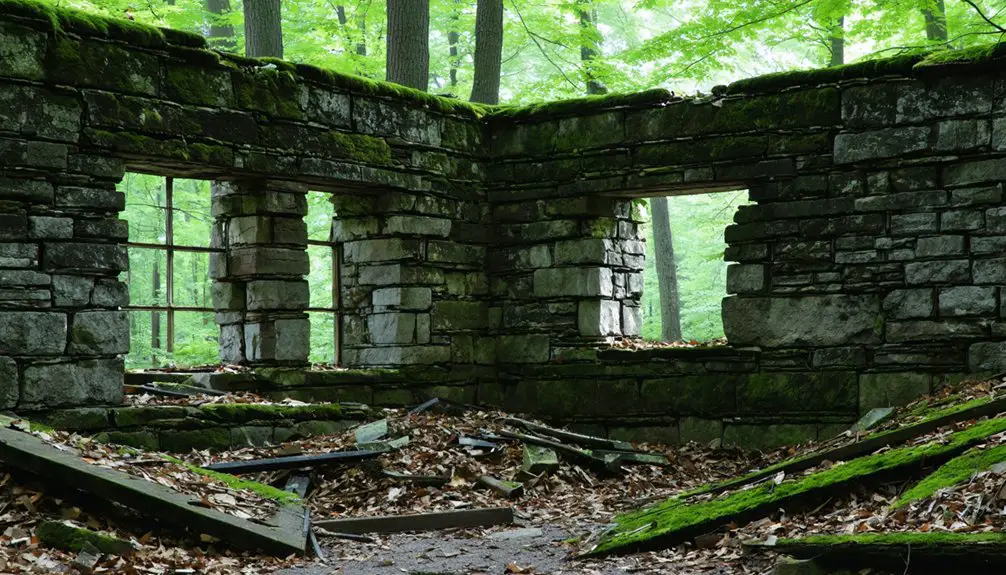
Hidden beneath a thick canopy of deciduous trees, modern-day Wehrum reveals its secrets through scattered remnants of its industrial past.
You’ll find the jail structure standing as one of the most visible urban exploration sites, though it’s now on private property. Along the Ghost Town Trail, you can trace shadowy outlines of former streets and discover concrete foundations hidden in the undergrowth.
The Orthodox Cemetery of Saints Peter and Paul offers a poignant glimpse into historical preservation, with weathered tombstones marking the final resting place of Wehrum’s residents.
The cemetery stands as a silent guardian of memory, its weathered stones whispering stories of those who built Wehrum’s legacy.
As you venture deeper into the woods, you’ll encounter the damaged Wehrum Dam and scattered building remnants. Nature has reclaimed much of this once-bustling company town, but careful exploration still yields glimpses of its century-old story.
Legacy of a Lost Mining Community
Deep within Pennsylvania’s coal country, Wehrum stands as a powerful symbol to America’s industrial past and the transient nature of resource-dependent communities.
You’ll find its legacy etched in the resilience of families who built their lives around the Lackawanna #4 mine, facing challenges from deadly explosions to economic uncertainty.
While most physical structures have vanished, Wehrum’s story of community resilience lives on through historical preservation efforts.
The remaining cemetery, jail ruins, and dam remnants serve as silent testimonials to the town’s once-vibrant life.
As part of the Ghost Town Trail, Wehrum continues to teach valuable lessons about the fragility of single-industry towns and the importance of economic diversity.
The town’s rapid rise and fall mirror countless other mining communities, reminding you of the true cost of America’s industrial development.
Frequently Asked Questions
Are There Any Surviving Descendants of Wehrum Miners Still Living in the Area?
Like faded coal dust tracks, you won’t find documented Wehrum ancestry in the area today. While Indiana County has general miner heritage, there’s no verified evidence of Wehrum miners’ descendants living locally.
What Was the Average Salary of Miners Working in Wehrum’s Coal Mines?
You’ll find coal mining wages from Wehrum’s era were quite different – the average miner earned about $1.50 to $2 per day in the early 1900s, roughly $40-50 in today’s money.
Did Any Paranormal Activity Get Reported in Wehrum After Its Abandonment?
Mysterious murmurs and mist-filled moments you’ll find in local lore, but there’s limited proof of paranormal sightings. While ghost stories circulate about the old cemetery, they’re mostly unverified tales from passing visitors.
How Many Children Typically Attended Wehrum’s School During Its Peak Years?
You’ll find school enrollment likely ranged between 30-50 students when the mining families were most active, though exact numbers aren’t documented. Most kids shared classrooms across multiple grade levels.
What Happened to the Bank Records and Town Documents After Abandonment?
Purposefully purged paperwork: your town’s bank records and administrative documents were likely destroyed or transferred to Lackawanna Coal and Bethlehem Steel’s archives after the 1929 closure, though their exact fate remains unknown.
References
- https://catbirdlife.com/fascinating-cemetery-haunts-episode-2-wehrum-pennsylvania/
- https://www.countryfoxexploring.com/ghost-town-wehrum/
- https://www.atlasobscura.com/places/wehrum
- https://kids.kiddle.co/Wehrum
- https://en.wikipedia.org/wiki/Wehrum
- https://appalachianrailtrails.com/industrial-heritage-the-ghost-town-trail/
- https://jamesrada.com/western-pennsylvania-ghost-towns/
- https://www.thetravel.com/what-to-know-about-hiking-the-ghost-town-trail-in-pennsylvania/
- https://wynninghistory.com/2025/01/23/pay-day-at-the-mines/
- https://www.nma.org/pdf/c_wages_state_industries.pdf
